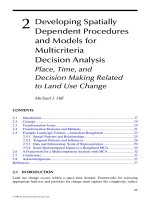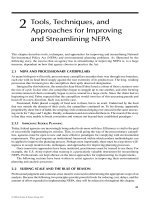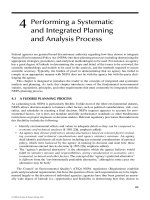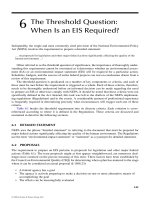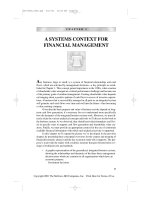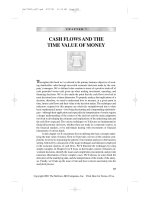Poverty Impact Analysis: Approaches and Methods - Chapter 2 pdf
Bạn đang xem bản rút gọn của tài liệu. Xem và tải ngay bản đầy đủ của tài liệu tại đây (135.95 KB, 14 trang )
CHAPTER 2
Poverty Predictor Modeling in
Indonesia: A Validation Survey
Bayu Krisnamurthi, Arman Dellis, Lusi Fausia, Yoyoh Indaryanti, Anna Fatchia, and Dewi
Setyawati
Introduction
The objective of this chapter was to assess and verify the explanatory or
predictor variables used for determining the poor. The predictor variables
were based on the earlier results of the poverty predictor modeling (PPM)
exercise using Indonesia’s National Socioeconomic Survey (SUSENAS)
discussed in Chapter 1 of this book. The PPM results were used as the basis
of the analysis. The verifi cation process was done using a local assessment
and survey. The overall results were then analyzed for their signifi cance in
determining poverty, especially their usefulness in identifying the poor and
improving poverty targeting.
Data and Approaches
Data used in this study emanated from a 2005 sample survey
1
of households
in Bogor, West Java, and Tangerang, Banten. The sample included 624
households selected from two groups, i.e., households which were covered in
the SUSENAS and households which were not covered in the SUSENAS.
For comparison, the secondary data of SUSENAS 2004 for the two districts
selected were used as the benchmark for classifying the households into poor
and nonpoor.
The poverty predictor variables examined in this study were classifi ed
according to the following characteristics:
ownership of electronic equipment (radio, TV, etc.);
level of education;
consumption pattern (no consumption of milk, meat, biscuits, or
bread in a week, do not get two meals a day);
household dependency ratio of more than 0.5;
1
The questionnaire used in the pilot survey can be downloaded at .
org/Statistics/reta_6073.asp.
•
•
•
•
Application of Tools to Identify the Poor
78 Poverty Predictor Modeling in Indonesia: A Validation Survey
household attributes (earth fl oor, impermanent walls, no sanitary
facilities, no electricity, etc.);
main source of income coming from informal sectors; and,
level of health (cleanliness of clothing, medication).
These variables are similar to those used in the three methods discussed
in the previous chapter which were found to be signifi cant in explaining
poverty.
In addition, as a complementary measure for deducing information about
household poverty status, independent assessments based on four local
sources were also used to better view and assess poverty. The perceptions
about household poverty status are taken from respondents, respondents’
neighbors, local authorities, and enumerators.
The respondent could be one of the most reliable sources of information
in assessing whether he or she is poor or nonpoor. Neighbors are another
source of information that are considered to be very reliable in judging a
respondent’s poverty status. The local authorities, as the bureaucracy closest
to the respondent, are also an important source of information in this aspect.
2
Lastly, the assessment of the enumerators, who visit the households during
the survey, is also important as they are an objective source of information.
These assessments, to some extent, can be used for comparison. Among all
these factors, the perception of the household respondent is considered most
reliable and is given a greater weight (2) than the perceptions of the other
three sources which are each given a weight of 1. Setting greater weight to
the respondent’s perception is deliberate; it aims to improve certainty in
determining the poverty status of the respondent.
With this weighting system, the lowest poverty score would be 0, which
means that all sources of information perceive that the respondent household
is nonpoor. In contrast, the greatest score would be 5 if all sources perceive
that the respondent household is poor. If the sum of the weights of perceived
poverty is 3 or more, the household is classifi ed as poor. The result of the
weighting process for all respondents is presented in Table 2.1.
Using the perception method, 363 of the total 624 household samples
were classifi ed poor and 261 nonpoor—with all four sources mostly agreeing
on the classifi cation of the households as poor or nonpoor. For example, as
many as 251 of the 363 poor households were assigned a local perception
weight of 5, which implies that all the sources consider these households as
2
However, uncertainty may arise due to, for instance, the presence of conflicts of interest,
which tend to distort the assessment of whether the respondent is really poor.
•
•
•
Poverty Impact Analysis: Tools and Applications
Chapter 2 79
poor. Similarly, 156 of the 261 nonpoor households were classifi ed as such by
all the sources. While perception studies are regarded as subjective by many
analysts, the consensus on the poverty status of the majority of households by
all sources is noteworthy and points to the usefulness of such studies.
Data Analysis Method
Data collected from the fi eld survey were analyzed through quantitative and
qualitative methods to validate variables that could be used as predictors.
The quantitative method is based on the application of the poverty line based
on the household’s expenditures and the qualitative method is based on the
perceptions of the local people in identifying the poor.
Quantitative Approach
The identifi cation of poverty predictor variables is done by using a logistic
(logit) regression model with the household poverty status of poor and
nonpoor as the dependent variable (see also the discussion on Method 2 in
Chapter 1 of this book). The difference between logistic and probit is that
logistic analysis is based on log odds while probit uses cumulative normal
probability distribution. The logistic model can be derived from the logistic
probability function or opportunity spread function.
3
The probability of a
respondent being poor or nonpoor can be formulated as:
)(
)(
1
xg
xg
i
e
e
+
=
S
)(
1
1
xg
e
+
=
3
Logistic regression calculates changes in the log odds of the dependent variable and
not changes in the dependent variable itself as in ordinary least squares regression.
Table 2.1 Assessing Poverty by Using the Weighted Perception Method
Poverty Assessment from
Local Perception
Sum of the Weight of
Perceived Poverty
Areas
Rural Urban Rural+Urban
Nonpoor
0 70 86 156
1211435
2333770
Total
124 137 261
Poor
3383169
4241943
5 126 125 251
Total
188 175 363
Total Respondents
312 312 624
Source: Authors’ calculation.
Application of Tools to Identify the Poor
80 Poverty Predictor Modeling in Indonesia: A Validation Survey
Where
ʌ
i
= likelihood of a respondent having the status of poor.
g(x) = a + bX
indicates how quickly the probability changes with changing a single unit of
X. Because the relation between X and ʌ
i
is nonlinear, the parameter b does
not have a straightforward interpretation as it does in the ordinary linear
regression.
4
By taking the natural logarithm from the ratio between the probability of
a respondent having the status of poor and that of nonpoor, it then follows
that:
)(
1
ln xg
i
i
=
S
S
Such an equation can be determined using the maximum likelihood
estimation technique specifi c for the logistic model which is provided in
several statistics and econometrics computer programs such as Microfi t
(Pesaran and Pesaran 1997).
To meet the logit model requirement, the poverty status assessment results
using the weighting system must be recategorized into two categories (binary
scale), i.e., poor and nonpoor. Nonpoor respondents are those who have
scores of 0–2, while poor respondents are those with scores of 3–5. To classify
them as binary-scale variables, the nonpoor respondent is assigned the score
of 0, and the poor respondent is given the score of 1. Once this is done, the
estimation for validation purposes can then be conducted.
The estimation of the logit model is divided into two, for two respondent
groups:
the logit model for all respondents whose poverty status appraisal
was based solely on the perception of the local community and
enumerator, and
the logit model for respondents whose poverty status appraisals are
consistent between the local community’s perception and the poverty-
line assessment based on household expenditures.
Logit model estimations for both groups are then further defi ned by
location: rural, urban, and total. Such divisions are made to identify the
4
See />•
•
Poverty Impact Analysis: Tools and Applications
Chapter 2 81
possibility of a difference of poverty predictors between urban and rural areas.
In rural and urban area regression equations, the variable district is added as
dummy variable; in the combination regression equation, the variable area is
added as its dummy variable to mean either rural or urban.
Variables used in the validation are the same as those used in the initial
stage of PPM. These variables were classifi ed according to:
ownership of farm animals, which comprise livestock (cattle, buffalo,
horses, or pigs), goats, sheep, lambs, poultry (chickens or ducks), and
fi sh;
ownership of assets such as electronic equipment (radios or tape
players, TVs, and satellite dishes), refrigerators, and telephones;
vehicles (bicycles, motorcycles, cars or trucks, and carriages); and
tools for production (hand tractors, crop machines, pumps, etc.);
ownership of sanitary facilities (toilets), clean- and potable-water
facilities, electrical connections, and cooking facilities;
physical condition of the house based on fl oor area, and materials of
the fl oor, walls and roof;
household characteristics such as age, family size, members with
formal education, members who are elementary school dropouts,
working members, average educational attainment, dependency ratio,
and occupation of the head of the family (formal or informal); and
consumption pattern for food and nonfood items or characteristic
such as rice, meat, eggs, and fi sh per week; clothes bought in a year;
incidence of illness among members in the past six months or the
previous year; and the practice of seeking medication when ill.
For each regression, a stepwise procedure is used to minimize the number
of variables included in the model. Tests on reliability in predicting poverty
status are also done by using cross tabulation between the predicted poverty
status as a result of logit model and the status based on the local perception.
Qualitative Approach
The qualitative approach is performed to explain the various characteristics
of the respondents, which comprise ownership of livestock, poultry,
fi sh, and assets; physical condition of the house and facilities; household
characteristics; and food consumption, health, and nutrition. Qualitative
analysis is implemented using cross tabulation between respondents’ poverty
status, various characteristics, and respondents’ perception.
•
•
•
•
•
•
Application of Tools to Identify the Poor
82 Poverty Predictor Modeling in Indonesia: A Validation Survey
Results
Poverty Classifi cation and Verifi cation
Poverty verifi cation in this study is based on two assessment approaches:
local perception and household expenditure using predetermined poverty
indicators. For each approach, classifying the household respondents into
poor and nonpoor is attempted.
Poverty Verifi cation Based on Local Perception. Table 2.2 shows that
based on local perception, 58.2 percent of household respondents are
considered poor. Of this
number, 30.1 percent were
perceived to be in rural areas
while 28.1 percent were in
urban areas. Corollary to
this, the perception is that
there are more nonpoor
households in the urban areas
(22.0 percent) than in the
rural areas (19.9 percent).
Poverty Verifi cation Based on Household Expenditures. Recalculating
the actual poverty line is considered necessary because of the dynamic
nature of the conditions of poverty. It is acknowledged that, after a year, the
condition of a household may change as a result of a change in the household’s
expenditures. Taking this into account, the verifi cation of the SUSENAS data
for 2004 is also based on the expenditures of the household.
Poverty verifi cation based on household expenditures is measured by
taking the average threshold of monthly household expenditure per capita,
which is Rp130,927
5
for Bogor and Rp132,108 for Tangerang in 2004. This
implies that households with per capita expenditures lower than the thresholds
for each of these districts will be considered poor, thus, these thresholds are
in effect pseudo poverty lines.
The results of poverty verifi cation based on household expenditures as
shown in Table 2.3 indicate that 58.7 percent of household respondents
are poor, and 41.3 percent are nonpoor. Furthermore, the number of
poor households in rural areas (36.2 percent) is higher than in urban
areas (22.4 percent) and the number of nonpoor households in rural areas
(13.8 percent) is less than in urban areas (27.6 percent).
5
Rp stands for rupiah; US$1 is roughly about Rp9,000 (2004).
Table 2.2 Classifying Poor and Nonpoor Households
by Using the Local Perception Approach
Respondent
Status
Area
Rural Urban Rural+Urban
Poor
188 175 363
30.1 % 28.0 % 58.2 %
Nonpoor
124 137 261
19.9 % 22.0 % 41.8 %
Total
312 312 624
50.0 % 50.0 % 100.0 %
Source: Authors’ calculation.
Poverty Impact Analysis: Tools and Applications
Chapter 2 83
Poverty Verifi cation Based on
Both Assessment Approaches.
The consistency, or the lack of
it, of the poverty verifi cation
results based on local perception
and household expenditures can
be tracked when the results are
presented in a single matrix. A
cross tabulation of the results
from the two different assessment
methods is thus presented in such
a matrix in Table 2.4. The table shows that based on local perception and
household expenditure assessments, 43.1 percent of the households in rural
and urban areas combined are poor and 26.3 percent are nonpoor. The rest
of the observations show inconsistent results between the two assessment
approaches. About 15.1 percent of the households are poor based on local
perception, but they are considered nonpoor based on expenditure. On the
other hand, 15.5 percent of the households are perceived as nonpoor by the
local community, but, based on expenditure, they are considered poor. It is
clear from these observations that results using expenditure data to identify
the poor will differ by about 15.0 percentage points compared with the result
using local perception, and vice versa.
Table 2.4 further reveals
that verifi cation results of
SUSENAS data for 2003/04
are consistent in the estimation
of the proportion of poor based
on pilot survey. Verifi cation
results based on local perception
show the 58.2 percent of the
respondents are actually poor
and 41.8 percent are nonpoor.
While verifi cation based
on recalculating household
expenditures (using the pseudo poverty line) has fairly similar results:
58.7 percent of the households are poor and 41.3 percent are nonpoor.
Poverty Estimation. The results of poverty estimation in rural and urban
areas are, interestingly, consistent with the verifi cation of SUSENAS data
for 2004 and in the assessment approaches based on local perception and
household expenditures. Even though there are slight differences, the three
assessment methods are in general relatively consistent, as seen in Table 2.5.
Verifi cation using the 2004 data shows that 48.7 percent of households
(25.8 percent in rural and 22.9 percent in urban areas) are classifi ed as
Table 2.3 Classifying Poor and Nonpoor
Households by Using the Expenditure
Approach of the Pilot Survey
Respondent
Status
Area
Rural Urban Rural+Urban
Poor
226 140 366
36.2% 22.4% 58.7%
Nonpoor
86 172 258
13.8% 27.6% 41.3%
Total
312 312 624
50.0% 50.0% 100.0%
Source: Authors’ calculation.
Table 2.4 Classifying Poor and Nonpoor
Households by Using the Local Perception and
Household Expenditure of the Pilot Survey
Approaches
Household Expenditures
Poor Nonpoor Total
Local Perception
Poor
269 94 363
43.1% 15.1% 58.2%
Nonpoor
97 164 261
15.5% 26.3% 41.8%
Total
366 258 624
58.7% 41.3% 100.0%
Source: Authors’ calculation.
Application of Tools to Identify the Poor
84 Poverty Predictor Modeling in Indonesia: A Validation Survey
poor (with low-expenditure households as a proxy for poverty). However,
the results are slightly different if the verifi cation is conducted using results
of recalculations based on household expenditures or local perception.
About 58.7 percent households are considered poor based on expenditure
assessment, i.e., 36.2 percent in rural and 22.4 percent in urban areas.
The results from using local perception verifi cation have similar results:
58.2 percent of households are considered poor, i.e., 30.1 percent in rural
and 28.0 percent in urban areas.
The above information also confi rms the dynamic aspect of poverty.
There is a difference of about 10 percentage points between the results of
the verifi cation from pilot survey using the data and the recalculation of
the poverty line based on household expenditures. About 48.7 percent
households are poor according to the SUSENAS data, but 58.7 percent are
poor according to the assessment based on expenditure. This means that
in one year, i.e., from the 2002 SUSENAS to the 2004 SUSENAS, about
10 percent of households experienced a fall in their total expenditures and
became poor. This highlights the vulnerability of people who are above but
close to the poverty line.
When the SUSENAS data is verifi ed using the results of local-perception
assessment, there is a slight difference in the ratio of poor and nonpoor
household groups. Based on the 2004 data, about 48.7 percent of households
are poor; but, based on local perception, 58.2 percent households are
considered poor. This means that 10 percent of the households considered
nonpoor in the 2004 are perceived as poor by the local communities.
Predictability of Poverty Variables
Estimation Results of the Local Perception Logit Model. The results of
a logistic regression model of respondents’ poverty status based only on local
perception (Appendix 2.1) show that the logistic models for rural, urban,
and total respondents have a relatively small pseudo R-squared value. The
retained predictors only explain 44.1 percent of the respondents’ poverty
status in rural areas and 52.3 percent in urban areas. The combination of
Table 2.5 Classifying Poor and Nonpoor Households by Using SUSENAS Data, Local
Perception, and Household Expenditures of the Pilot Survey Approaches
Area
SUSENAS Household Expenditures Local Perceptions
Poor Nonpoor Total Poor Nonpoor Total Poor Nonpoor Total
Rural
25.8 24.2 50.0 36.2 13.8 50.0 30.1 19.9 50.0
Urban
22.9 27.1 50.0 22.4 27.6 50.0 28.0 22.0 50.0
Rural+Urban
48.7 51.3 100.0 58.7 41.3 100.0 58.2 41.8 100.0
SUSENAS = National Socioeconomic Survey
Source: Authors’ calculation.
Poverty Impact Analysis: Tools and Applications
Chapter 2 85
rural and urban respondents resulted in an even smaller pseudo R-squared
value (38.1 percent). Small R-squared values are, however, usually found
in regression models with dichotomous variables. In predicting power, the
result shows 83.3 percent is true for the model for rural areas, 86.5 percent
for urban areas and 79.5 percent for the total. The following is a summary on
the predictability of the retained variables.
Asset Ownership. The variables for ownership of refrigerators, TVs, and
motorcycles have positive values and are signifi cant for rural areas, while the
ownership of TVs and motorcycles are signifi cant for the urban areas. The
regression for total respondents shows that the three asset-ownership variables
are also signifi cant and consistent. Since the variables are specifi ed in terms of
nonpossession of these assets, the positive values mean that households which
do not have refrigerators, TVs, and motorbikes have a higher probability of
being poor compared with those who have these assets.
House Characteristics. House characteristics in rural and urban areas are very
different. In rural areas, the type of wall in a house has positive values,
meaning that if a house does not have a brick concrete wall the household is
more likely to be poor. In urban areas, the signifi cant variable is fl oor area.
The more spacious the house, the less likely the household is poor.
House Facility. Toilet ownership is signifi cant in the three models and has
positive values. This implies that the poor are less likely to have a toilet and
nonpoor households tend to have their own toilet.
Household Characteristics. The retained variables for the model for rural areas
are: a family member dropped out from elementary school, the head of
family works in the informal sector, and the household dependency ratio
is no more than 0.5. The fi rst variable has a positive effect on rural poverty.
The last two variables are signifi cant in equations for both rural and urban
areas as well as for total respondents. On the other hand, variables that are
signifi cant and have positive values in urban areas are: having household
members who did not complete their primary education and the square of the
number of working household members. A household’s size has a signifi cant
and positive effect on poverty, while the number of household members
with schooling has a negative effect for rural and urban areas combined.
Therefore, poor households are identifi ed as having many family members,
a member or members who have dropped out of primary school, a relatively
small number of working household members or a high dependency ratio,
and a main wage earner who is working in the informal sector.
Consumption, Food, Nutrition, and Health. In the last group of variables, having
insuffi cient rice (staple food) and not having eaten meat, eggs, and fi sh in the
reference period are a positive and signifi cant poverty predictor variable in
Application of Tools to Identify the Poor
86 Poverty Predictor Modeling in Indonesia: A Validation Survey
all areas. The use of medical facilities and paramedics is also a signifi cant
poverty predictor variable with a positive coeffi cient in rural and urban areas
combined.
Characteristics of Location. The location characteristic is a signifi cant dummy
variable. Findings shows that a rural community in Bogor has a lower
probability of being poor than a rural community in Tangerang. On the other
hand, an urban community in Bogor has a higher probability to be classifi ed
as poor than an urban community in Tangerang. The difference could be
related to the characteristics of the two districts. Bogor is basically agrarian,
with ample employment opportunities in the rural area. Tangerang, on the
other hand, is basically industrial, with better employment opportunities in
urban areas. This fi nding highlights the importance of taking characteristics
of region and location into account in developing the poverty predictor
model.
Estimation Results of the Perception-Expenditure Logit Model. The
perception-expenditure logit model refers to the logit model estimation for
respondents whose poverty status based on their expenditure is consistent
with the local community’s perception. The results (Appendix 2.2) are similar
to the results from the poverty estimation model in terms of variable and
estimation procedures.
Analyzing respondents with consistent perception-expenditure results
from the model, shows that the pseudo R-square value increased compared
with the previous estimate of 38.1 percent. In rural areas, the model can be
used to explain 66.4 percent of the respondents’ poverty status; in urban
areas, 76.6 percent can be explained; and, for all respondents, 66.3 percent
can be explained. In addition, there are some new predictor variables that
resulted from this model. The variables of ownership of cows in rural areas
and sheep in urban areas were found to be signifi cant in predicting poverty.
The variables of TV and motorbike ownership remain signifi cant in rural
areas. In urban areas, however, the ownership of telephones, radios or tape
recorders, and motorbikes are signifi cant. For total respondents, however,
the ownership of a radio or tape recorder becomes insignifi cant.
House ownership was not signifi cant among rural, urban, or total
respondents and so it was not used as a poverty predictor variable in the
perception-expenditure model. On the other hand, the use of simple cooking
utensils powered by wood is a poverty indicator in rural areas. In urban
areas, the ownership of toilet is a signifi cant predictor variable, which is
consistent with the fi nding from the poverty estimation discussed in the
previous section
Poverty Impact Analysis: Tools and Applications
Chapter 2 87
Household-specifi c variables show that family size, education level of
household members, and household-head employment are important poverty
predictor variables. Having rice and eating meat, eggs, and fi sh in the past
week are consistent with the previous estimation result. A new variable on
health appears in urban areas: a household whose members are frequently
sick has a higher probability of being poor.
In general, the estimate for the perception-expenditure model results in
some main poverty predictors such as:
non-ownership of electronics (TV, radio, or tape recorder), refrigerator,
telephone, or motorbike;
house has no personal toilet and the household uses simple cooking
utensils fi red by wood in rural areas;
large family size, small number of household members in school, and
low average education level of household members;
family earner works in the informal sector and relatively small number
of working household members (high dependency ratio, less than 0.5)
and;
not owning suffi cient staple food (rice), nutrition defi ciency (unable to
consume meat, eggs, and fi sh at least once a week), and poor health
and inability to visit a general practitioner or hospital for medical
care.
Compared with the SMERU result based on the SUSENAS data, several
variables out of the seven indicators of poverty are consistent except household
characteristics. In this study, family size is an important poverty indicator
compared with the SMERU result. In addition, household’s inability to have
suffi cient rice and use of fi rewood as a fuel are also poverty predictors in rural
areas in this study but not in SMERU.
Accuracy of the Predictor Variables. The capability of predictor variables
to explain poverty can also be seen by comparing the actual poverty status
of the household with the predicted poverty status. The predictive value for
the dependent variable is distributed as 0 or 1, thus, requiring households
to be classifi ed as poor or nonpoor. This means a clustering process can be
done automatically using the Microfi t computer program. In this context,
households with more than 50 percent probability of being poor are classifi ed
as poor and, conversely, nonpoor if the probability is less than 50 percent.
6
By cross tabulating the actual and predicted household poverty status, two
sets of results can be obtained. The fi rst is shown on Table 2.6 based on
6
This classification technique is commonly applied in econometrics (Verbeek 2000).
The classification used here is slightly different than the classification used in the
study by Sumarto, Suryadarma, and Suryahadi (Chapter 1 of this book). In that study,
households with more than 50 percent poverty probability were classified as poor (see
also Sumarto 2004).
•
•
•
•
•
Application of Tools to Identify the Poor
88 Poverty Predictor Modeling in Indonesia: A Validation Survey
local community’s perception and the second is shown in Table 2.7 based on
consistent perception-expenditure respondents.
Table 2.6 indicates that 47.8 percent of total households in rural and
urban areas together are classifi ed as poor and 29.5 percent as nonpoor. The
accuracy and effectiveness of poverty indicators can be obtained by adding the
primary diagonal elements in the table. For example, the effectiveness of the
poverty indicator
7
for rural areas is 83.4 percent—the sum of the percentage
of households that were predicted to be nonpoor and were actually nonpoor
(29.2 percent) and the percentage that were predicted to be poor that were
actually poor (54.2 percent). For urban and total respondents, therefore,
the effectiveness of the poverty indicator is 86.6 percent, and 77.3 percent,
respectively. The numbers demonstrate the combined accuracy of predicting
the poor and nonpoor. Note that 9.9 percent and 7.4 percent of households,
who are actually nonpoor, were predicted to be poor in rural and urban areas,
respectively. On the other hand, 6.7 percent and 6.1 percent of households
who are actually poor, were predicted as nonpoor in rural and urban areas,
respectively.
In the group of respondents having consistent poverty status based on
perception and expenditure, the effectiveness of prediction is higher, i.e.,
93.1 percent, 82.2 percent, and 91.0 percent for rural, urban, and total
respondents, respectively. As a result, the prediction margin of error is
minimized at 7 percent for rural and total households, and 17.8 percent for
urban households. Based on this result, the effectiveness of signifi cant variables
in the logit model is quite high and could be used as poverty predictors in
rural and urban areas.
7
This refers to the sum of the primary diagonal elements in Table 2.6.
Table 2.6 Predicting Poor and Nonpoor Using the Logit Model for All Respondents
Predicted
Rural Urban Rural + Urban
Nonpoor Poor Nonpoor Poor Nonpoor Poor
Actual
Nonpoor
29.2% 9.9% 36.9% 7.4% 29.5% 12.3%
Poor
6.7% 54.2% 6.1% 49.7% 10.4% 47.8%
Source: Authors’ calculation.
Table 2.7 Predicting Poor and Nonpoor Using the Logit Model for Respondent with
Consistent Poverty Status Based on Perception-Expenditure Approaches
Predicted
Rural Urban Rural+Urban
Nonpoor Poor Nonpoor Poor Nonpoor Poor
Actual
Nonpoor
20.3% 4.5% 35.9% 13.4% 32.3% 5.5%
Poor
2.5% 72.8% 4.3% 46.3% 3.5% 58.7%
Source: Authors’ calculation.
Poverty Impact Analysis: Tools and Applications
Chapter 2 89
Appendix 2.1 Results of Logit Model Using SUSENAS Data
(Dependent Variable: 1 = Poor, 0 = Otherwise)
Predictor Rural Urban Rural-Urban
Asset Ownership
household has no refrigerator
(1 = yes, 0 = otherwise)
2.5497 *
(2.7777)
-
0.99917 **
(2.3669)
household has no television
(1 = yes, 0 = otherwise)
.94076*
(2.7540)
1.2358*
(2.9711)
0.75323*
(3.1516)
household has no motorcycle
(1 = yes, 0 = otherwise)
1.7534*
(3.5333)
1.2285**
(2.2257)
1.3661 *
(4.1772)
House Characteristics
area of the floor of the house
(in m2 )
-
-0.0081**
(-2.0726)
-
wall of the house is not made from concrete brick
(1 = yes, 0 = otherwise)
1.4996*
(4.2669)
-
0.63639 *
(2.8749)
House Facility
household has no toilet
(1 = yes, 0 = otherwise)
0.78152 **
(2.0539)
1.4393*
(3.6155)
1.0624*
(4.4039)
Household Characteristics
Household size
(in person)
0.23871*
(3.0599)
household members schooling
(in person)
-0.26253***
(-1.9314)
average household education did not finish primary school
(1 = yes, 0 = otherwise)
-
1.2100*
(2.8863)
1.0800*
(4.6711)
household members have dropped out of primary school
(1 = yes, 0 = otherwise)
0.91053 **
(2.1784)
square of number of household members who are working
(in person)
-
0.18311*
(2.9057)
-
head of household work in informal sector
(1 = yes, 0 = otherwise)
2.1656*
(4.7848)
1.6854*
(3.5813)
0.67244**
(2.0749)
dependency ratio of this household is less than 0.5
(1 = yes, 0 = otherwise)
0.9246**
(2.1262)
1.9828*
(3.9781)
0.90756*
(3.3196)
Consumption, Food, Nutrition and Health
this household has insufficient rice consumption
(1 = yes, 0 = otherwise)
2.2314**
(2.5507)
0.89972
(1.5858)
1.6790*
(4.0677)
household that has not consumed meat, egg or fish in the past week
(1 = yes, 0 = otherwise)
2.3752*
(4.3885)
1.5896*
(3.1905)
0.72304**
(2.4352)
treated at the local health centre (Puskesmas). medical aide (mantri),
midwife (bidan) or traditionally
(1 = yes, 0 = otherwise)
-
0.72577***
(1.8511)
-
Dummy Variable for District and Rural-Urban Area
dummy variable for district
(1 = Bogor, 0 = otherwise)
-1.4041*
(-3.5623)
2.1659*
(4.4066)
-
dummy variable for rural-urban area
(1 = rural, 0 = otherwise)
-0.52526
(-2.2028)
Constant -6.6374*
(-5.6238)
-6.4282*
(-6.6906)
-5.1900*
(-8.3197)
Goodness of fit 0.83333 0.86538 0.79487
Pseudo R-squared 0.44112 0.52338 0.38120
Numbers of Observation 312 312 624
*** Significant at 10%; ** Significant at 5%; * Significant at 1%
SUSENAS = National Socioeconomic Survey
Source: Authors’ calculation based on 2004 SUSENAS.
Appendix
Application of Tools to Identify the Poor
90 Poverty Predictor Modeling in Indonesia: A Validation Survey
Appendix 2.2 Logit Model Results with Consistent Poverty Status Based on Perception
and Expenditure Approaches (Dependent Variable: 1 = Poor, 0 = Otherwise)
Variable Rural Urban Rural-Urban
Animal Ownership
household has no goat
(1 = yes, 0 = otherwise)
-
1.9877**
(2.2427)
-
household has no cow or buffalo
(1 = yes, 0 = otherwise)
2.6187**
(2.3838)
Asset Ownership
household has no telephone
(1 = yes, 0 = otherwise)
-
5.8899*
(3.3749)
3.1160*
(2.6862)
household has no radio and tape recorder
(1 = yes, 0 = otherwise)
-
1.8490*
(2.9378)
-
household has no refrigerator
(1 = yes, 0 = otherwise)
2.4053*
(2.8421)
household has no television
(1 = yes, 0 = otherwise)
1.7068 **
(2.2640)
- .84419 **
(2.0015)
household has no motorcycle
(1 = yes, 0 = otherwise)
2.3037**
(2.1901)
5.2100*
(3.1299)
2.1997 *
(3.4043)
House Facility
household uses firewood
(1 = yes, 0 = otherwise)
2.6151*
(3.5262)
Household has no toilet
(1 = yes, 0 = otherwise)
-
2.4252*
(3.1952)
0.95967**
(2.4583)
Household Characteristics
household representative age
(in year)
0.0249***
(1.9341)
household size
(in person)
1.2020*
(3.6570)
1.1673*
(4.5025)
0.86228*
(5.1340)
household members at school
(in person)
-1.1316**
(-2.3962)
-
-0.58246**
(-2.1169)
average household education not graduating primary school
(1 = yes, 0 = otherwise)
1.6499**
(2.4445)
-
0.72488***
(1.8308)
head of family has worked in informal sector
(1 = yes, 0 = otherwise)
3.2554*
(3.0022)
6.2795*
(4.4332)
2.8647*
(4.4632)
Dependency ratio of this household is less than 0.5
(1 = yes, 0 = otherwise)
0.86421***
(1.8269)
Consumption, Food, Nutrition and Health
household insufficient rice consumption
(1 = yes, 0 = otherwise)
3.3702**
(2.2405)
-
2.0157*
(2.6448)
household has not consumed meat, egg or fish in the past week
(1 = yes, 0 = otherwise)
1.6757**
(1.9750)
3.6518*
(3.4965)
1.6350*
(2.6765)
household member sick in the past year
(1 = yes, 0 = otherwise)
-
2.2932*
(2.9120)
.81583***
(1.8044)
treated at village clinic, medical aide (mantri), nurse or traditionally
(1 = yes, 0 = otherwise)
0.96881**
(2.1529)
Dummy Variable for Regency
dummy variable for regency
(1 = Bogor, 0 = otherwise)
-4.2598*
(-3.7720)
0.5729*
(2.8348)
-
Constant -10.7518*
-4.3221)
-27.7208*
(-5.1578)
-15.9654*
(-6.9889)
Goodness of fit 0.93069 0.93506 .90993
Pseudo R-squared 0.66390 0.75600 .66315
Numbers of Observation 202 231 433
*** Significant at 10%; ** Significant at 5%; * Significant at 1%
Source: Authors’ calculation.

